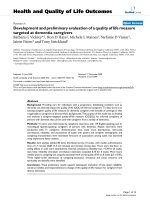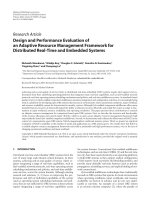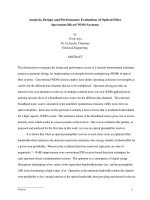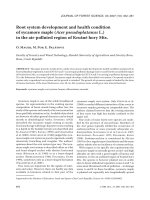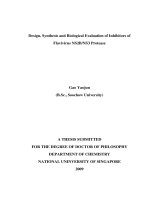Design, development and performance evaluation of manure spreader- A review
Bạn đang xem bản rút gọn của tài liệu. Xem và tải ngay bản đầy đủ của tài liệu tại đây (582.56 KB, 10 trang )
Int.J.Curr.Microbiol.App.Sci (2019) 8(9): 2530-2539
International Journal of Current Microbiology and Applied Sciences
ISSN: 2319-7706 Volume 8 Number 09 (2019)
Journal homepage:
Review Article
/>
Design, Development and Performance Evaluation of
Manure Spreader- A Review
C. Naveen Kumar* and N. L. Kalyan Chakravarthi
Department of Farm Machinery and Power Engineering,
College of Technology and Engineering, Udaipur-313001, Rajasthan, India
*Corresponding author
ABSTRACT
Keywords
Fertilizer, Spreader,
Application rate,
Coefficient of
uniformity
Article Info
Accepted:
24August 2019
Available Online:
10 September 2019
Application of fertilizers plays a vital role in crop production system. The
basic performance parameter for a fertilizer distributor was uniformity of
distribution over a wide range of conditions. In India traditionally manure
was distributed with the help of fork and other mechanical device which
was very tedious and slow process. The study of the previous work done on
fertilizer applicators shows that manually operated, animal drawn and
tractor drawn spreader has been developed in India to achieve uniformity in
application with minimum time and drudgery of labor. Some of those
studies have been reviewed in this study.
Introduction
Agriculture remains the principal source of
livelihood for majority of the population in
India. The increased use of synthetic fertilizers
and chemical pesticides in agriculture started
in India since 1960s as part of the Green
Revolution. Over the past five decades
synthetic
fertilizers'
consumption
has
drastically increased several folds and India is
now one of the leading producers of
agrochemicals in the world. Soil is an essential
nutrient source for the plant, crop plants draw
nutrients from the soil and therefore,
application of fertilizer is very important to
maintain
the
productivity
of
soil
(Krishanchandra, 2005). We witnessed a
change from organic to inorganic agriculture
and now, thinking a move towards organic
again (Sathyanarayana et al., 2002).
Nutrient supply in crop system should be
economically viable, environmental friendly
and socially acceptable without affecting the
gross plant production (Krishanchandra,
2005). Meanwhile, Organic manure is
considered as eco-friendly bio-fertilizers for
highly polluted modern era. When comes to
application method of dry fertilizer,
broadcasting and mixing into the soil after
2530
Int.J.Curr.Microbiol.App.Sci (2019) 8(9): 2530-2539
plowing is popular in Indian farms. Use of
manpower for application of organic materials
is uneconomical due to high labor cost. Thus,
it attracted wide attention in various parts of
world (Kunal et al., 2018). In modern
agriculture, tractor has become integral part of
mechanized agriculture. In this context, in
India various types of fertilizers spreaders
have been developed to achieve uniformity in
application rate and to reduce drudgery
meanwhile to increase agriculture production
(Suthakar et al., 2008).
Design Parameters
The basic performance parameter for a
fertilizer distributor is uniformity of
distribution over a wide range of conditions.
The uniformity of spreader is determined
primarily by the performance of the metering
devices. The metering device should have a
positive dispensing action with fertilizers
covering a range of drill abilities. It is
desirable that the discharge rate be
proportional to the forward speed of the
implement so the application rate per hectare
will be independent of speed. The design
should be such that there are no appreciable
cyclic variations in discharge rate. The rate
should be adjustable in small increments and
should have a definite relation to a suitable
reference scale provided on the unit (Kepner
et al., 1987).
Metering Devices
Many different types of metering devices for
fertilizers have been developed in recent years
in attempting to obtain a consistent and
uniform metering action under the wide
variety of conditions encountered in
distributing fertilizers. Some of the principles
employed in present day distributors are
described in the following paragraphs.
Hopper with centrifugal spreader disk consists
of hopper, which is used to keep the Manure.
It also accommodates the flow metering
mechanism. The bottom corner side of hopper
contains hole and adjustor. The manure may
come out from the hole and the adjustor is
used to adjust the hole. The rate of flow of
manure may controlled by the adjustor. In a
spreader disk types the rotating member
generally driven by ground wheel. The drive
gear is fastened at the center of the horizontal
shaft between the wheels. The driven is
connected at the one end of the vertical
column. The spreader disk is placed at the
other end of the vertical column as shown in
Fig. 1. When the forward movement of the
machine occurs, the drive gear rotate along
with the wheel so by that the driven gears also
rotates (Jayamurthy et al., 2018).
In similar fashion Vignesh et al., (2018) also
developed the spreader where they have given
power by two stroke engine shown in Fig 2.
Due to centrifugal action of the spreader disk,
the manure will spread around the field.
Chain conveyor with centrifugal wheel,
Conveyor is made to carry manure in forward
direction with maximum 100 RPM, for
movement of conveyor tractor P.T.O. taken
for rotation and by ratchet mechanism.
Centrifugal wheel was used to give direction
to manure towards the rotating plate, the
centrifugal wheel also consist of crusher
which was used to crush over size manure. It
takes P.T.O. rotation and with chain drive it
rotates with maximum 135 RPM (Kunal et al.,
2018). Material used is Wooden Ply, Big
Chain, M.S sheet, Ratchet & Pawl.
Chain conveyor with feeder plate, (Suthakar et
al., 2008) developed a tractor operated manure
spreader where, a chain conveyor was used to
carry the manure towards the spreader from
the front end of the tub with help of feeder
plate. The 16 feeder plates 1000 × 40 × 6 mm
were welded to the endless chain with an
interval distance of 450 mm. Also, two
2531
Int.J.Curr.Microbiol.App.Sci (2019) 8(9): 2530-2539
inverted “L” angles 1000 × 40 × 40 × 6 mm
were provided between the feeder plates to
remove the manure completely from the tub.
The forward movement of the chain was
achieved through the drive shaft, which was
mounted at the front side of the manure tub.
The driven shaft was mounted at the rear side
of the manure tub. The chain was connected to
the drive and driven shaft in such a way that it
ran longitudinally over the manure tub.
In similar fashion Sapkale et al., (2010) have
developed tractor operated manure spreader
where an endless conveyor was provided at
the bottom of the trailer for conveying the
manure towards the rear end. For shearing off
the manure and its distribution, swinging
hammer type beaters were provided at rear
end.
Spiral auger, Singh and Singh (2014) have
developed animal drawn FYM spreader
where, a manure spreading auger made of
mild steel spiral discs of 2 mm thickness was
provided below the manure box. The diameter
of disc is 200 mm. the discs are welded on MS
pipe of 48 mm in such a way that the discs
deliver manure directly to the ground. At both
ends of the pipe bearings have been provided
for rotation of auger. It is used to crush the
lumps and spreading the manure. Chain and
sprocket arrangement have been provided for
rotating auger.
Stationary opening metering devices are
common on drop type as well spreading type
applicators. The rate is controlled by adjusting
the size of the openings. A rotating spreader or
agitator after openings will spread the manure
which will come in contact with them.
Naveenkumar et al., (2017) have developed a
tractor operated FYM spreader where they
have employed a adjustable frame opening
shown in fig. to control the flow of farmyard
manure. They have operated manure spreader
by lifting tractor trolley at different slope in
order to make flow of manure from front side
of trolley to rear side where rotating spreader
unit is given. In order to control huge or mass
flow of manure to spreader unit they have
provided adjustable frame. It can be lift up and
down according to the application rate.
Similarly, Reddy et al., (2013) have developed
a animal drawn manure spreader. Sliding plate
is mainly used for adjustment of opening area
in the manure box. Sliding plate is made from
MS sheet and has on the bottom of platform
below the agitator to control the manure
delivery rate two handles were provided to the
sliding plate, which helps the push or pull
(forward and backward direction) the sliding
plate inside the manure box. Thus by
increasing or decreasing the opening width,
the manure delivery rate is controlled. The
sliding plate controls the opening for dropping
the manure. The agitator assembly is fixed
below the manure box for agitating the
manure during working position. A manure
spreading agitator is fixed at middle portion of
main frame of rectangular chassis. The main
function of agitator is to agitate the manure
from manure box.
Factors affecting discharge rate
Present day metering devices have a positive
action in dispensing part of flow but also
depend partly upon gravity. Stationary
opening arrangements depend largely upon
gravity. Auger feeds, conveyor feed units are
positive displacement devices. Discharge rates
from metering devices that are not positive
acting are materially affected by the type and
condition of the fertilizer and by operating
conditions, the extent of the effects being
related to the degree of dependence upon
gravity flow. One of the important factors
affecting discharge rates is the drillability of
fertilizer. Drillability or ease of flowing is
affected by such factors as the hygroscopicity
of the fertilizer, relative humidity at which it is
2532
Int.J.Curr.Microbiol.App.Sci (2019) 8(9): 2530-2539
stored, the size and shape of particles,
presence of lumps, the bulk density and the
compaction characteristics of the material
(Kepner et al., 1987).
Mehring and Comings, 1930 found a definite
relation between the kinetic angle of repose
and the discharge rate, they concluded that the
drillability of a fertilizer is inversely
proportional to the angle of repose and that
fertilizers with angles of repose greater than
about 550 cannot be metered satisfactorily
with the most type of equipment.
Singh and Singh, 2014 concluded that the
farmyard manure is heterogeneous material
and moisture content of its changes with the
depth of the storage pit. Hence angle of
friction is more important for sliding the
manure over a sheet as compared to angle of
repose.
They also observed the variation of manure
deliver rate at different levels of manure filled
in the manure box. Meanwhile it is also
evident by the research of Malgeryd and
Wetterberg, 1996 the bulk density of solid
manure affects spreading properties such as
the flow of manure and the working width.
Factors affecting application rate
Generally application rate of fertilizer
spreader vary with the size of opening and
forward speed. Some of such research have
discussed in below paragraphs.
The research of Patil and Munde, 2017
showed that the application rate of manure
during manure spreader operation varies from
2.46 to 10.06 t/ha for different opening areas
of cover from 0.04 m2 to 0.16 m2,
respectively. The developed manure spreader
cum cart has desired manure application rate
of 9-10 t/ha for 0.16 m2 opining area of cover
at the operational speed of 2.63 km/hr. The
increase in manure delivery rate with increase
in opening area of delivery slot was due to
availability of more area, allowing increased
quantity of manure to pass through.
The similar result was observed by the Jain
and Lawrence, 2015. The manure delivery rate
varied with variation in size of opening and
ranged between 0.38 to 0.83 kg per second
with the increase in opening area.
When it comes to the forward speed of the
machine over application rate Suthakar et al.,
(2008) observed that the application rate of the
manure was significantly decreased when
increasing the forward speed. The reason was
that when the forward speed was increased,
application of manure over the field must be
reduced.
Meanwhile chain conveyor speed was also
influenced the application rate but researcher
found no significant effect of drum speed in
application rate. The desired application rate
of manure (12.20 t/ha) was observed at the
forward speed of 2.31 km/h and the chain
conveyor speed of 1.51 m/min with the
effective width of 1.20 m and saving in time
of 50-60 per cent when compared to the
conventional method.
Similar results were observed by Thakur et al.,
(2015) according to them increase in engine
rpm and forward speed will increase field
capacity but it will decrease application rate.
The investigation of Shen et al., (2011) to
know the causes for differences in compost
application rate in a field using two types of
manure spreaders and clarifying it by
measuring the travel tracks of the manure
spreaders using a RTK-GPS system showed
the differences in compost application rate are
due to the changes in travel speeds and track
distances.
2533
Int.J.Curr.Microbiol.App.Sci (2019) 8(9): 2530-2539
Table.1 Application rate of manure for different combinations
Chain conveyor
speed, m/min
Spreader
speed, m/min
2.26 m/min
25.12 m/min
37.68 m/min
47.10 m/min
25.12 m/min
37.68 m/min
47.10 m/min
25.12 m/min
37.68 m/min
47.10 m/min
1.88 m/min
1.51 m/min
Application rate of manure (tones/ha) at selected
levels of forward speed
1.88 km/min
2.31 km/min
4.00 km/min
16.16
16.40
16.92
18.85
17.96
18.47
20.11
20.41
20.25
10.39
9.94
10.08
10.59
10.86
10.74
12.22
12.62
12.02
6.93
7.22
7.06
8.43
7.87
8.09
9.22
8.87
9.46
Table.2 Manure application rate and coefficient of variation at different manure delivery rate and
speed of operation.
Fig.1 Hopper with centrifugal spreader disk
2534
Int.J.Curr.Microbiol.App.Sci (2019) 8(9): 2530-2539
Fig.2 Spreader layout (Vignesh et al., 2017)
Fig. 3.a Conveyor
Fig. 3.b Centrifugal wheel
2535
Int.J.Curr.Microbiol.App.Sci (2019) 8(9): 2530-2539
Fig.4 Chain conveyor
Fig.5 Spiral auger used for manure spreading
Fig.6 Tractor operated farmyard manure spreader with adjustable frame opening
2536
Int.J.Curr.Microbiol.App.Sci (2019) 8(9): 2530-2539
Fig.7 Effect of Engine Rpm and Forward Speed on Manure Application Rate and Field Capacity
In the same way results of Sharabasy et al.,
(2007) shows that the increasing the gate
opening area leads to increase the application
rate (kg/h), but the increase in machine
forward speed leads to decrease the
application rate (kg/fed) due to the increase in
machine field capacity. In another research of
Batta et al., (2015) the effective field capacity
of the manure spreader increased with increase
in forward speed and engine rpm. As the
forward speed of the tractor was increased
engine rpm the effective length over which the
manure was spreaded also increased. Thus it
leads to increase in effective area over which
the manure was applied resulting in decrease
in manure application rate per unit area.
The effect of engine rpm and gear individually
and in combination was significant on
(p<0.05) on manure application rate. As the
engine rpm level and gear levels were
increased the manure application rate Fig.7.
Factors affecting uniformity in application
Suthakar et al., (2008) measured the spread
pattern for the all the treatments. Where they
were plotted using values averaged over three
replications with tray position in X-axis and
amount of manure collected in tray is in Yaxis.
The application in tones per hectare decreased
with increase in speed of the tractor and
increase with decrease in the linear speed of
the chain conveyor. In all the treatments
spread pattern obtained was a flat top profile,
which was acceptable form from the point of
achieving uniform spreading.
It is very much evident that the forward speed
and chain conveyor speeds had a significant
effect on the uniformity of application.
Similarly Sapkale et al., (2010) and Thakur et
al., (2015) also recorded that the forward
speed and conveyor speed had a significant
effect on co-efficient of uniformity in manure
application.
It was recorded by Hanna and Richard, 2008
that the varying spreader swath interval affects
application rate and uniformity. In general, a
narrower swath interval increases application
uniformity, but increases overall application
2537
Int.J.Curr.Microbiol.App.Sci (2019) 8(9): 2530-2539
rate. Singh and Singh, 2013 have recorded that
the increase in manure application rate will
decrease the co efficient of variation, which in
turn increase the coefficient of uniformity.
Jain and Lawrence, 2015 also have showed
that the coefficient of uniformity of the
manure spreader also varied with variation in
manure delivery rate. The co-efficient of
variation decreased from 23.42 per cent to
15.62 per cent with increase in manure
delivery rate from 0.38 kg to 0.83 kg/s.
Very least work has been done on design of
manure spreader. The existing tractor drawn
Manure spreader is heavy and difficult to
maintenance. The performance of this
spreader on farm field gives effective
spreading with low cost and reduction of time,
while animal drawn spreader require separate
cart which is used only for carrying manure. It
require spiral auger which is complex to
manufacturing. The animal drawn spreader is
economically efficient but it consume more
time as compared to tractor drawn spreader.
Review also underlines the need of manure
spreader which is easy to operate and design.
References
Batta, R., Narang, M. K. and Chandel, R.
2015. Field and economic studies of
tractor operated manure Spreader with
rear vertical rollers- a need based study
for organic farming approach in indian
agriculture. International Journal of
Agricultural Science and Research. 5:
347-356.
Hanna, H. M. and Richard, T. L. 2008.
Calibration and uniformity of solid
manure. Agric. Envi. Ext. Publications.
13: 1-7.
Jain, A. K. and Lawrence, A. K. A. 2015.
Performance Evaluation of Bullock
Drawn
Farm
Yard
Manure.
International Research Journal of
Engineering and Technology. 2: 313316.
Jayamoorthy, M., Raj, A. S. A. P. and
Jayabharath, P. 2018. Agriculture
Manure Spreader for Natural Farming.
International Journal for Scientific
Research and Development. 6: 163615.
Kepner, R.A., Roybainer and Barger. E.L.
1978. Principles of farm machinery.
Text book.
Krishanchandra. 2005. Organic manure.
Unpublished thesis. M.sc. Univ. Agric.
Sci. Dharwad.
Kunal, K. M., Saurabh, J. S., Mohit, L. S. and
Priyanka, G. 2018. Design &
Fabrication of Cow-Dung Spreader.
International Journal for Research in
Engineering
Application
and
Management. 8: 552-556.
Malgeryd, J. and Wetterberg, C., 1996.
Physical properties of solid and liquid
manures and their effects on the
performance of spreading machines. J.
Agric. Engg. Res. 64: 289-298.
Mehring, A. L., and G. A. Cumings. 1930.
“Factors Affecting the Mechanical
Application of Fertilizers to the Soil,”
U.S. Department of Agriculture,
Technical
Bulletin
No.
182,
Superintendent of Documents, U.S.
Government
Printing
Office,
Washington, D.C.
NaveenKumar, C., Prakash, K. V.,
Anantachar, M., Veerangouda, M. and
Nagaraj. N. 2017. Performance
Evaluation of Tractor Operated
Farmyard Manure Spreader. Res. J. of
Agric. Sci. 8: 816-820.
Patil, S. T. and Munde, P. A. 2017.
Performance evaluation of an animal
drawn manure spreader cum cart.
Engineering and technology in India.
8: 80-92.
Reddy, M., Prakash, K. V., Veerangouda, M.
and Yarnal, R. S. 2013. Development
2538
Int.J.Curr.Microbiol.App.Sci (2019) 8(9): 2530-2539
of animal operated farm yard manure
applicator. Int. J. Agric. Engg. 6: 519523.
Sapkale, P. R., Mahalle, S. B. and Bastewad,
T. B. 2010. Performance evaluation of
tractor operated manure spreader. Int.
J. Agric. Engg. 3: 167-170.
Sathyanarayana, V., Varaprasad, P. V.,
Murthy, V. R. K. and Boote, K. J.
2002. Influence of use of farmyard
manure and inorganic fertilizers on
yield and yield components of irrigated
lowland rice. J. Plant Nutri. 25: 20812090.
Sharabasy, M. M. A., Ali, M. M. A. and Afify,
M. K. 2007. Manufacturing and
evaluation of a self-propelled machine
for broadcasting seeds and granular
fertilizers. J. Agric. Engg. 24: 752-774.
Shen, B., Satow, T. and Maeda, S. 2011.
Evaluation of travel tracks of tractor
drawn manure spreaders using RTKGPS. Engg. Agric. Envi. 4: 112-118.
Singh, R. C. and Singh, C. D. 2013.
Development and performance testing
of a tractor trailer cum farmyard
manure spreader. Agric. Engg. Today.
37: 65-79.
Singh, R. C. and Singh, C. D. 2014. Design
and development of an animal drawn
farm yard manure spreader. African J.
Agric. Res. 9: 3245-3250.
Suthakar, B., Kathirvel, K., Manian, R. and
Manohar, J. D. 2008. Development
and performance evaluation of manure
spreading attachment to two wheel
trailer. AMA. 39: 22-28.
Thakur, S., Chandel. And Narang, K. 2015.
Evaluation of tractor operated manure
spreader with rear vertical rollers. J.
Agric. Res. 52: 54-58.
Vignesh, B., NavaneethaKrishnan, M. and
Sethuraman, N. 2018. Design &
Fabrication of Automatic Fertilizer
Spreader. Int. J. for Sci. Res. and Dev.
5: 1133-1135.
Yadav, G.D. and Pawar, M.S. 2015, Design
and Development of Manure Spreader
- A Review. Int. J. of Engg. Res. and
Gen. Sci. 3: 262-265.
How to cite this article:
Naveen Kumar, C. and Kalyan Chakravarthi, N. L. 2019. Design, Development and
Performance Evaluation of Manure Spreader- A Review. Int.J.Curr.Microbiol.App.Sci. 8(09):
2530-2539. doi: />
2539
